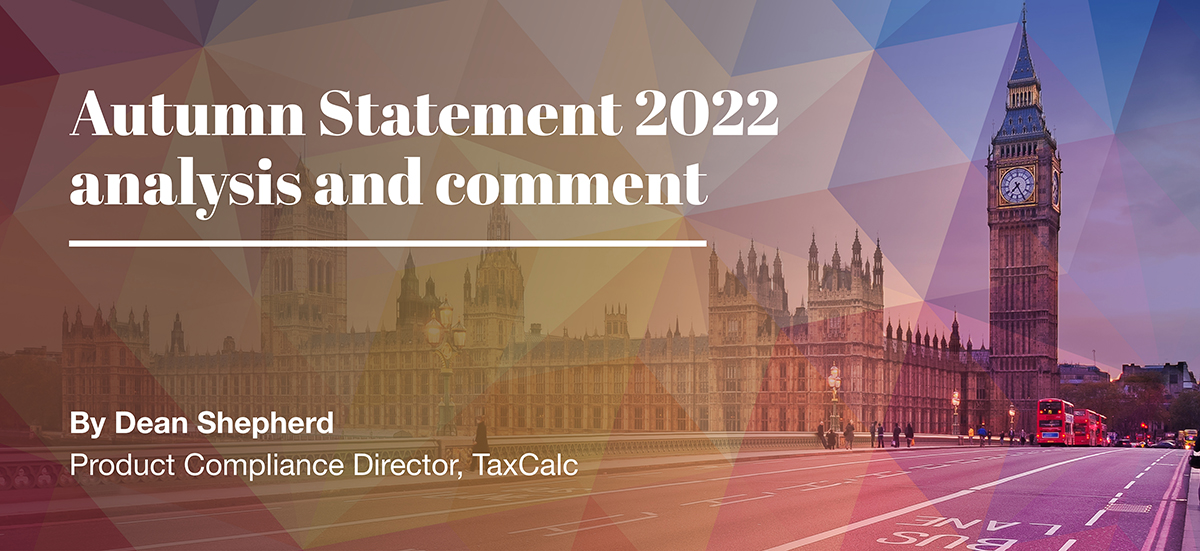TaxCalc Blog
News and events from TaxCalc
A recessionary budget from a principled chancellor?

The Chancellor, Jeremy Hunt, today confirmed that the UK is now officially in recession. His response was to introduce two new fiscal rules and two new fiscal principles.
- Rule 1: That the UK’s national debt must fall as a share of GDP by the fifth year of a rolling five-year period; and
- Rule 2: That public sector borrowing in the same year must be below 3% of GDP.
Overall, the Autumn Statement is set to improve public finances by £55 billion by 2027-28, with the OBR forecasting both of these rules to be met a year early in 2026-27.
With regard to his decisions on tax, he offered the following principles in the interests of fairness:
- Principle 1: We ask those with more, to contribute more; and
- Principle 2: We avoid the tax rises that most damage growth.
As with any budgetary announcement, only time will tell (though surely the incumbent Chancellor will have more time than his predecessor).
The key takeaways:
Reduction of additional rate tax threshold
The additional rate threshold will reduce from £150,000 to £125,140 with effect from 6 April 2023. If you’re wondering why such a specific figure rather than a round £125,000? Well, the personal allowance of £12,570 gets abated by £1 for every £2 of income above £100,000. Therefore, the 45% tax rate will apply only once the personal allowance has been fully abated.
Income Tax and National Insurance thresholds fixed until April 2028
This measure will maintain the following personal tax thresholds at their 2023/24 levels until at least April 2028:
- Income Tax: Personal Allowance (PA) and Higher Rate Threshold (HRT);
- National Insurance: Primary Threshold (PT), Lower Profits Limit (LPL), Lower Profits Threshold (LPT), Upper Earnings Limit (UEL), and Upper Profits Limit (UPL)
Inheritance Tax thresholds fixed until April 2028
This measure fixes the Nil-Rate Band and Residence Nil-Rate Band thresholds at £325,000 and £175,000 respectively until at least April 2028. It also fixes the Residence Nil-Rate Band taper at the current level of £2 million.
Planned rise in Corporation Tax confirmed
Confirmation that, from 6 April 2023, the main rate of Corporation Tax will leap from 19% to 25% for businesses with profits exceeding £250,000. Businesses with profits under £50,000 will continue to pay at 19% and those in between will be subject to the resurrected marginal rate relief calculations from days gone by.
Reduction of the Dividend Allowance
This measure reduces the tax-free allowance for dividend income (the Dividend Allowance) from £2,000 to £1,000 from 6 April 2023 and then to £500 from 6 April 2024 for individuals who receive dividend income.
Reduction of the CGT Annual Exempt Amount
This measure reduces the Capital Gains Tax (CGT) Annual Exempt Amount (AEA), which is currently set at £12,300 for individuals and personal representatives and £6,150 for most trustees.
- for 2023-24, the AEA will be £6,000 for individuals and personal representatives and £3,000 for most trustees.
- for 2024-25 and beyond, the AEA will be permanently fixed at £3,000 for individuals and personal representatives and £1,500 for most trustees.
The measure also fixes the CGT proceeds reporting limit at £50,000. This measure will have effect from April 2023.
CGT extension to the nil gain/nil loss period to three years for couples that separate or divorce
This measure increases the period in which spouses and civil partners who are in the process of separating can make no gain and no loss transfers of assets between themselves to three years; and unlimited time if the assets are the subject of a formal divorce agreement. Previously, separating couples had until the end of the tax year of their separation. It also introduces rules that apply to individuals who have maintained a financial interest in their former family home following separation and that apply when that home is eventually sold. These changes apply to transfers that occur on or after 6 April 2023.
Electric cars to pay Vehicle Excise Duty (road tax)
This measure will equalise the VED liability of all alternatively fuelled vehicles (AFVs) and internal combustion engine (ICE) vehicles from April 2025. This change will apply to both new and existing AFVs.
Increase in Company Car Tax for electric and ultra low emission cars
This measure increases Company Car Tax (CCT) percentages by 1 percentage point for Electric Vehicles (EVs) and the <75g CO2 Ultra Low Emissions Vehicles (ULEV) band in 2025-26. Rates will increase a further 1 percentage point in 2026-27 and a further 1 percentage point in 2027-28, with rates for all other bands increased by +1% up to a maximum Appropriate Percentage (AP) of 37%.
Top-up tax for UK headquartered multinational groups
Pillar 2 of the OECD corporate tax reforms will ensure that multinational enterprises pay a minimum 15% rate of tax on profit in every country in which they operate.
For accounting periods beginning on or after 31 December 2023:
- an Income Inclusion Rule (IIR) will require large UK headquartered multinational groups to pay a top-up tax where their foreign operations have an effective tax rate of less than 15%, and
- a supplementary Qualified Domestic Minimum Top-up (QDMTT) tax rule will require large groups to pay a top-up tax where their UK operations have an effective tax rate of less than 15%.
They will apply to large businesses operating in the UK with global revenues over 750m euros.
Rebalancing of R&D tax reliefs
This measure changes the relief that can be claimed by businesses through the research and development expenditure credit (RDEC) and the research and development tax relief for small and medium-sized enterprises (SME). The new rates will be 20% for RDEC (currently 13%), 86% additional deduction for SME (currently 130%), and 10% for SME payable credit (currently 14.5%) will take effect from April 2023.
Stamp Duty Land Tax reversal
After 31 March 2025, the residential nil-rate threshold will return to £125,000 from £250,000 and the First Time Buyers’ Relief nil-rate threshold will return to £300,000 from £425,000. The maximum amount that an individual can pay while remaining eligible for First Time Buyers’ Relief will return to £500,000 from £625,000.
No change to VAT threshold
This measure maintains the VAT registration threshold at £85,000 for a further two years, in 2024-25 and 2025-26.
Car fuel and van benefit charge to increase in line with inflation
The car fuel and van benefit charges are imposed when an employer provides their employee with car fuel for personal journeys or a van which is available for private use. A van benefit charge is not incurred for commuting where other conditions are met. This measure will increase the both charges in 2023-24 in line with growth in CPI.
See how much you could save
Whether you're just getting started in practice, or an established firm see how much TaxCalc could save you.
Get a quote





